BruceR offers some typically thoughtful suggestions for operationalizing Maj. Jim Gant’s “One Tribe at a Time” approach, which I tore to shreds here, but have since seen increasingly mentioned as playing a major role in the Obama administration’s strategy discussions. Here’s Bruce’s jumping off point: You can’t rebuild Afghanistan using Gant’s methods, true, but I thinkit’s really being looked into more as another method of keeping theenemy hopping in areas where a sustained government or ISAF presence isuneconomical at present. And that’s not a totally crazy idea. If the alternatives are Predator strikes and SOF kinetic ops involvingblack-painted helicopters and […]
South Asia Archive
Free Newsletter
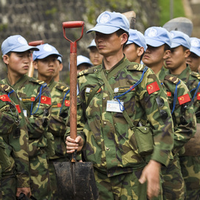
“Rebalancing” has been the watchword of President Barack Obama’s foreign policy to date: rebalancing the global economy between East and West, rebalancing domestic needs and foreign responsibilities, and — soon enough — rebalancing the international security burden among the world’s great powers. One number explains why that last rebalancing is necessary: It costs the United States $1 million a year to keep a soldier inside a theater of operations such as Afghanistan. The math is easy enough: For every thousand troops, the price comes out to $1 billion a year. So when the president announces, as he’s expected to do […]
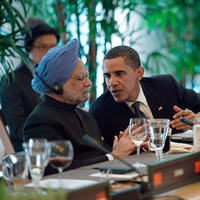
In hosting Indian Prime Minister Manmohan Singh this week for the first state visit of his administration, President Barack Obama can claim to be taking India seriously as a partner and rising power. But Indian doubts remain. U.S.-India relations are currently drifting, rather than surging forward as they had been for a decade. Bilateral ties developed an unprecedented intimacy under President George W. Bush, capped by an agreement on civilian nuclear cooperation that required both countries to take considerable political risks and overcome stubborn international opposition. Building on work begun by President Bill Clinton, Bush and his Indian counterparts unshackled […]
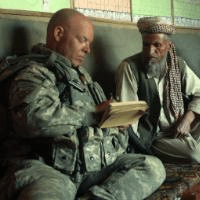
KANDAHAR, Afghanistan — Two years after its formation, a controversial military program to embed civilian social scientists inside combat units in Iraq and Afghanistan is scrambling to recover from a string of crises. How the so-called “Human Terrain System” responds to a spate of combat deaths and a disastrous employee pay cut will determine whether the program survives in its current form. Human Terrain System, headquartered at Fort Leavenworth, in Kansas, is the brainchild of Montgomery McFate, a Harvard- and Yale-trained anthropologist. In a series of journal articles(.pdf) in 2005, McFate outlined the basic shape of what would become HTS. […]
Bilateral economic ties are sure to be at the top of the agenda forIndian Prime Minister Manmohan Singh’s visit with President BarackObama in Washington this week. India, though still home to a staggering800 million people living on $2 a day, has an economy that is booming.The New York Times’ Vikas Bajaj tells Fred de Sam Lazar of NewsHourthat it was most likely the Indian perception of undeveloped financialinstitutions that saved their economy from the toxic assets that led tothe financial crisis.
The Pakistani army says they have made progress in South Waziristan inthe first five weeks of their campaign. Faster than expected, the armyhas driven Taliban leaders out of the region — they’ve “melted away”as one analyst put it. Army officials say their strategy has been tocut off Taliban supply lines and to go after forests and caves. Thoughthe campaign has been instrumental in changing public opinion of theTaliban, analysts say it is unlikely that the army will launch asimilar campaign in the North. Voice of America’s Meredith Buelreports.
President Barack Obama and Indian Prime Minister Manmohan Singh speakat the official arrival ceremony for Singh. The ceremony is the firstof its kind since Obama has been in office. “It is fitting that you andIndia be so recognized,” Obama told Singh. The following days willpresent India and the United States with opportunities to discuss keyissues such as enhancing bilateral trade and the war in Afghanistan.
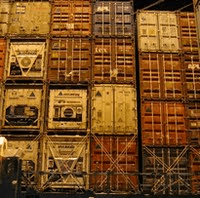
Describing the changes taking place in the world after the fall of the Berlin Wall, Henry Kissinger once declared that the unification of Germany would be more important than the integration of the European Union, the fall of the Soviet Union more important than the unification of Germany, and the rise of India and China more important than the fall of the Soviet Union. He was right. Since the fall of the Berlin Wall, the rise of the Asian superpowers has been the most important factor in world politics. It is also the single trend most responsible for the increasing […]

NEW DELHI — Indian Prime Minister Manmohan Singh’s scheduled visit to Washington on Nov. 24 is imbued with a special significance for both the United States and India, one magnified by the fact that Singh is the first head of state to be accorded the honor of an official state visit since President Barack Obama moved into the White House. The prestige accorded to India is befitting its growing geopolitical heft, its example as a peaceful and peace-loving nation and its status as the world’s largest democracy. And there’s no denying that the invitation has also helped mellow the resentment […]
Al Jazeera’s Tony Birtley reports on the fragile peace process takingplace in Nepal. Negotiations have been stalled as Maoists come toterms with the fact that operating as a legitimate unit within thegovernment may be their only feasible option for moving forward.Meanwhile, the coalition government is standing firm, refusing to makeconcessions to the Maoist opposition.
In his inauguration speech yesterday, Afghan President Hamid Karzai set a five-year timeline for Afghan security forces to take the lead in securing the country. The Times (UK) misleadingly headlined that, “Karzai: Foreign troops out of Afghanistan in five years.” But more interesting, because more realistic, he also set a two-year deadline for national and international security contractors to end their operations in the country. And by calling on national Afghan security forces to take over their roles, he leaves it a bit unclear whether when he refers to Afghan security contractors, he means “arm the tribes”-type militias. Here’s the […]
One of the consequences of the U.S. dependence on Pakistan to achieve its goals in Afghanistan is the way in which it drives India and Iran closer. That’s because their interests in Afghanistan largely converge, in opposition to those of Pakistan. It’s also obvious that U.S. interests in Afghanistan more closely align with those of India and Iran than with those of Pakistan. But to actually operationalize that would essentially turn the Afghanistan war into the Pakistan war. Clearly, the ideal solution would be for India and Pakistan to resolve their differences, and for the U.S. and Iran to do […]
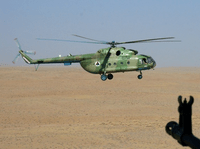
KANDAHAR, Afghanistan — The Afghan helicopter, a brand-new Russian-made Mi-17*, wasn’t clearly his, but U.S. Air Force Maj. Darren Brumfield was still determined to keep it. His unit, the 438th Air Expeditionary Training Group, needs four transport helicopters to perform its mission, and in early November, the group had just three. Assembled in Kandahar in April and tasked with mentoring the local Afghan National Army Air Corps wing, the group “shadows” and advises its Afghan counterparts as the Afghans maintain and fly the helicopters on behalf of the Afghan military. But of the three helicopters the unit did have on […]
Take it with the usual grain of salt, but the Pakistani daily, the Nation, is reporting that militants in North Waziristan used Israeli, Czech and U.S. weapons against Pakistani security forces during the recent campaign there. Apparently, the weapons, which include Uzis as well as M-4s fitted with grenade launchers and laser sights, are also widely available on the Punjab weapons market. According to the article, the presence of the Israeli weapons is what’s really raising eyebrows in Islamabad. I suppose the American weapons are more easily explained. Things have a habit of falling off of trucks, after all. Especially […]
– China announces yet another military cooperation upgrade, this time with Thailand. – This article about the followup to the Obama-Hatoyama meeting includes a good rundown of what the U.S.-Japan dispute over the Futenma air base closure is all about. – I mentioned the various competing plans for Asian regional integration earlier today. Here are the broad outlines of Japanese Prime Minister Yukio Hatoyama’s version. – In the runup to the one-year anniversary of the Mumbai attack, Pakistani Foreign Minister Shah Mahmood Qureshi issues a call for renewing the Composite Dialogue with India. – Turkey moves forward with its Kurdish […]
This NY Times piece, “No Parade for Hans,” is a great illustration of how Afghanistan has remilitarized European militaries, but not European opinion. Apparently, that goes double for Germany. There’s been increasing pressure on Germany to assume a higher military profile globally. This article gives a good idea of what that pressure is up against. The same popular opposition to the Afghanistan war exists here in France, as does the indifference to those serving. But anecdotally, I haven’t sensed any hostility toward French soldiers themselves for their involvement in Afghanistan. Of course, France has a less complex relationship to its […]
Over at the Interpreter, Hugh White writes that despite its (predictable) drawbacks, the F-35 remains the best option for Australia’s air force. White’s argument echoes the major outlines of the Australian defense debate, which Craig Snyder examined in his WPR Strategic Posture Review for Australia. Essentially, that boils down to whether Australia has a vocation to compete with “Asian major powers” (White’s term that I assume refers to China, India and Japan), or just with the lesser powers on its periphery in Southeast Asia. I’m flagging the article not so much to wade into that debate myself, but rather to […]
